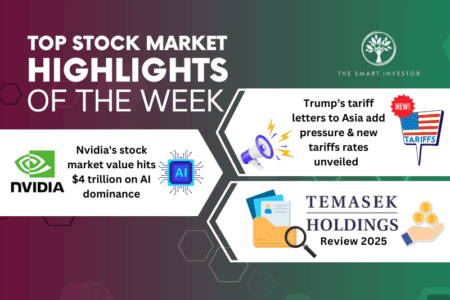We frequently receive messages from our members.
There’s one, however, that caught my eye.
In so many words, the member asked, my four-digit investment in Nvidia (NASDAQ: NVDA) is touching six digits now.
What should I do, he asked?
It’s a great question which many out there may be facing.
As a background, Nvidia was a stock pick of ours back in September 2018 before we started The Smart Investor.
Today, shares are up over 1,850%, excluding dividends, or more than 19 times.
It’s a phenomenal performance over five-plus years — and a good problem to have.
The rise and rise of Nvidia
Currently, Nvidia is standing shoulder to shoulder with two of the largest companies in the world, namely Microsoft (NASDAQ: MSFT) and Apple (NASDAQ: AAPL).
But when it comes to stock performance, there is no comparison.
According to Barron’s, Nvidia shares rose by a massive 240% in 2023, outpacing Microsoft’s 58% year-on-year gain and Apple’s 49% share price increase.
The difference in share price performance extended into 2024.
This year, Nvidia shares are up over 120% based on the Barron’s article.
For a sense of scale, Nvidia has contributed almost a third of the S&P 500’s (INDEXSP: .INX) gain so far in 2024.
That’s a single stock doing the heavy lifting in an index with around 500 stocks.
There’s a good reason why its shares are rising.
When in doubt, look at the business
For the fiscal year ended 31 January 2024 (FY2024), Nvidia’s revenue soared by 126% year on year to US$61 billion while its free cash flow (FCF) jumped by more than sevenfold to US$27 billion.
This year, analysts are projecting its revenue to tip the scales at US$120 billion.
In fact, long-range projections suggest that Nvidia could be raking in US$246 billion in sales in FY2029.
That’s why shares are trading at a high value point today.
At around US$131 per share today, Nvidia sports a price-to-FCF (P/FCF) of almost 83 times or almost 1.75 times more than Microsoft’s P/FCF of 47.5 and Apple’s P/FCF of 33.
The real question is whether Nvidia can live up to its billing.
It’s no secret that Nvidia has been at the centre of the Generative AI (GenAI) boom.
At the heart of the skyrocketing demand are its graphics-processing units (GPUs), invented in 1999.
The GPU’s parallel processing has become a staple in deep learning, an advanced AI technique to feed machines with huge amounts of data to help them learn by trial and error.
Nvidia’s overnight success, 25 years in the making
While Nvidia looks like an overnight success today, its foundations were built over multiple years.
Here’s a gist.
In 2006, Nvidia made its GPUs programmable through its CUDA (Compute Unified Device Architecture) platform.
The programmable nature of its GPUs enabled third-party developers and partners to build applications on its architecture.
For context, last year, there were over 4.7 million developers using CUDA and other Nvidia software tools to help deploy Nvidia’s technology worldwide.
CUDA has been a differentiator, and it’s not its only advantage in GPUs:
- For a better connection between GPUs, Nvidia introduced NVLink in 2014. Nvidia’s latest iteration, the Blackwell platform, includes the fifth generation of NVLinks which can support 576 GPUs.
- Then, in 2019, Nvidia acquired Mellanox for US$6.9 billion. The transaction brought InfiniBand on board, an architecture designed to support data flow between processors and I/O (input/output) devices and an industry standard for high-performance computing.
- Three years later, in 2022, Nvidia took another step by introducing its first ARM-based data centre central processing unit (CPU), the Nvidia Grace CPU Superchip. The Grace CPU consists of two CPU chips connected by NVLink for high-speed, low-latency (read: low processing delays), chip-to-chip interconnect.
- Still on CPUs, the new NVIDIA GB200 Grace Blackwell Superchip connects two NVIDIA B200 Tensor Core GPUs to the Nvidia Grace CPU using NVLink.
If the tech makes your head spin, you’re not alone.
But understand this point: it’s not just one advantage. Nvidia has deliberately built-in layers of technological advancements with each new iteration of its GPU.
In the short term, it has the upper hand.
Get Smart: So, what should you do?
In the short term, it’s impossible to predict how the shares are going to behave.
With a high P/FCF, Nvidia shares could fall if its results disappoint.
On the other hand, shares could still rise if the business continues to outpace expectations.
As investors, our view should be on the long term, and how Nvidia can sustain its advantage. If it can do so, then shares should do well.
But as a person, let us not lose sight of why we invest in the first place.
Plainly speaking, at the Smart Investor, we are advocates of stock investing.
But we also recognise that it is a vehicle to get you to where you want to go.
So, if the gains at Nvidia today have helped you close in on your financial goals, we would say that it has fulfilled its purpose. After all, you are successful when you achieve your own goals and not because you beat the market or did better than your peers.
Let that be your North Star for future decisions.
We have just revealed the top 7 US tech stocks poised for remarkable growth. In today’s fast-paced market, betting on these giants could mean more money in your pocket. With a focus on solid fundamentals and innovative prowess, these selections should earn a place in your portfolio. Click here to grab your FREE report now and start investing in the future, today.
Follow us on Facebook and Telegram for the latest investing news and analyses!
Disclosure: Chin Hui Leong owns shares of Microsoft and Apple.





